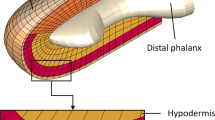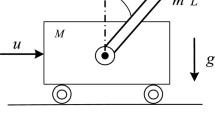Abstract
The use of hydraulic systems in industrial applications has become widespread due to their advantages in efficiency. In recent years, hybrid actuation systems, which combine electric and hydraulic technology into a compact unit, have been adapted to a wide variety of force, speed and torque requirements. A hybrid actuation system resolves energy consumption and noise problems characteristic of conventional hydraulic systems. A new, low-cost hybrid actuator using a DC motor is considered to be a novel linear actuator with various applications such as robotics, automation, plastic injection-molding, and metal forming technology. However, this efficiency gain is often accompanied by a degradation of system stability and control problems. In this paper, to satisfy robust performance requirements, tracking performance specifications, and disturbance attenuation requirements, the design of a robust force controller for a new hybrid actuator using Quantitative Feedback Theory (QFT) is presented. A family of plant models is obtained from measuring frequency responses of the system in the presence of significant uncertainty. Experimental results show that the hybrid actuator can achieve highly robust force tracking even when environmental stiffness set-point force varies. In addition, it is understood that the new system reduces energy use, even though its response is similar to that of a valve-controlled system.
Similar content being viewed by others
References
R. Rahmfeld and M. Ivantysynova, Displacement controlled linear actuator with differential cylinder—a way to save primary energy in mobile machines, In Proc. of the 5th Int. Conf. on Fluid Power Transmission and Control (ICFP), Hangzhou, China. (2001) 316–322.
J. Andersson, P. Krus and K. Nilsson, Optimization as a support for selection and design of aircraft actuation systems, In Proc. of the Seventh AIAA/USAF/NASA/ISSMO Symposium on Multidisciplinary Analysis and Optimization, St. Louis, USA. (1998).
B. Yao, F. Bu, J. Reedy and G. Chiu, Adaptive robust motion control of single-rod hydraulic actuators: theory and experiments, In IEEE/ASME Trans. on Mechatronics. 5 (1) (2000) 79–91.
A. Alleyne, R. Liu and H. Wright, On the limitation of force tracking control for hydraulic active suspensions, In Proc. of the American Control Conf. (1998) 43–47.
Y. N. Chen, B. C. Lee and C. H. A. Tseng, Variable-structure controller design for an electro-hydraulic force control servo system,J. Chin. Soc. Mech. Engrs. 11 (6) (1990) 520–526.
G. Wu, N. Sepehri and K. Ziaei, Design of a hydraulic force motion control system using a generalized predictive control algorithm, In IEE Proc. on Control Theory and Applications. 145 (5) (1998) 428–436.
F. Conrad and C. J. D. Jensen, Design of hydraulic force control systems with state estimate feedback, In Proc. of the IFAC 10th Triennial Congress, Munich, Germany. (1987) 307–312.
J. Grabbel, On the control of joint integrated servo actuators for mobile handling and robotic applications, In Proc. of the 1st FPNI-PhD Symp. Hamburg. (2000) 449–465.
J. Andersson, Sensitivity analysis in Pareto optimal design, In Proc. of the 4th Asia-Pacific Conf. on Simulated Evolution and Learning, SEAL 02, Singapore. (2002) 18–22.
J. Andersson, P. Krus, K. Nilsson and K. Storck, Modelling and simulation of heat generation in electro-hydrostatic actuation systems, In Proc. of the 4th JHPS Int. Symposium on Fluid Power, Tokyo, Japan. (1999) 15–17.
J. Andersson, P. Krus and D. Wallace, Multiobjective optimization of hydraulic actuation systems, In Proc. of ASME Design Automation Conf., Baltimore, USA. (2000) 11–13.
M. B. Leahy, D. E. Bossert and P. V. Whalen, Model-based control with quantitative feedback theory, In Proc. of IEEE Int. Conf on Robotics and Automation, (1) (1990) 1982–1987.
D. Thompson, J. S. Pruyn and A. Shukla, Feedback design for robust tracking and robust stiffness in flight control actuators using modified QFT technique, In Proc. of ACC Conf., San Diego, CA, USA. (1999) 754–758.
S. J. Rober, Y. C. Shin and O. D. I. Nwokah, A digital robust controller for cutting force control in the end milling process,ASME journal of Dynamic System, Measurement and Control. 119 (2) (1997) 146–152.
N. Niksefat and N. Sepehri, Robust force controller design for a hydraulic actuator based on experimental input-output data, In Proc. of the American Control Conf. 5 (5) (1999) 3718–3722.
D. F. Thompson and G. G. Kremer, Quantitative feedback design for a variable-displacement hydraulic vane pump, In Proc. of the American Control Conf. 2 (2) (1997) 1061–1065.
K. K. Ahn and H. T. C. Nguyen, Force control of hybrid actuator using learning vector quantization neural network,In KSME Int. Journal of Mechanical Science and Technology. 20 (4) (2006) 447–454.
J. J. D’Azzo and C. H. Houpis, Linear Control System Analysis and Design, McGraw-Hill, New York, USA, (1998).
I. M. Horowitz, Quantitative Feedback Design Theory (QFT). CO: QFT, Boulder, (1992).
L. Lennart, System Identification Toolbox — for use with MATLAB, The Mathworks Inc., Natick, Massachusetts, (1995).
Author information
Authors and Affiliations
Corresponding author
Rights and permissions
About this article
Cite this article
Ahn, K.K., Chau, N.H.T. & Truong, D.Q. Robust force control of a hybrid actuator using quantitative feedback theory. J Mech Sci Technol 21, 2048–2058 (2007). https://doi.org/10.1007/BF03177463
Received:
Revised:
Accepted:
Issue Date:
DOI: https://doi.org/10.1007/BF03177463




